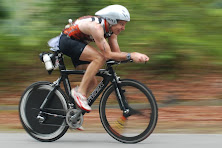 (Courtesy of www.slowtwitch.com)
(Courtesy of www.slowtwitch.com)At the end of the 3rd stage of the 2007 Tour de France, Fabian Cancellara famously attacked the field from 1km out and managed to hold off a charging swarm of sprinters to win the stage. On that day he was riding a Cervelo Soloist shod with Zipp model 808 wheels. Afterwards, he excitedly told Zipp's Chief Engineer Josh Poertner "808 is the new 404 for me!" Jens Voigt had been riding Zipp's 808 wheels in flat stages and seeing this, Cancellara had decided to try them as well. As he related to Poertner later, "I just felt like when I went, I knew I was riding a TT bike compared to what these other guys were on." Obviously, the potential of aerodynamics (especially of the wheels) to have a decisive effect in a bike race was not lost on Mr. Cancellara.
Let's fast forward to 2010-2011. In May of 2010, Zipp announced a reworking of their 404 wheels with a completely new shape for that wheel's depth of 58mm. These wheels appear to turn Spartacus' 2007 quote on it's head. In many ways these new wheels equal or outperform the 808s that Fabian rode to victory in 2007. Now then, I'm no Fabian Cancellara (I'd be lucky if I'm equivalent to just ONE of his legs), however, after recently riding a set of the new Zipp Firecrest 404 carbon clincher wheels and digging through the data produced by Zipp and comparing it to my own observations, I'm beginning to think that a new quote is appropriate: "Firecrest 404 is the new 808!"
 Firecrest Shape Development
Firecrest Shape DevelopmentDuring the development of the Firecrest 404 wheels, Zipp engineers decided to take a slightly different approach than has typically been used in thinking about and designing the rim shape. In the past, they general approach has been to think about the tire as the leading edge of an aerodynamic foil and then designing the rim shape with that as the foremost assumption. Doing so works fairly well, but the trade-off in that decision is that this shape may not work particularly well in the rear part of the wheel, where the shape is "reversed" to the air flow. In other words, the approach was to design for the front half of the wheel to be as good as possible, and then the rear "is what it is". In some cases, the rim designers don't even go to that extent, and this is evidenced by the "V" shaped rims still being produced. Those shapes aren't even particularly good for the front half of the wheel.
With their previous generation of rim shapes (what they called "hybrid toroidal"), the Zipp engineers had done a fairly good job of coming up with a shape that works really well on the front half of the wheel across a wide range of yaws, and is also relatively insensitive to tire width. Even so, this shape, when "reversed" on the trailing half of the wheel, didn't perform anywhere near as well as it did on the leading half of the wheel. So, the new thought process used in designing the Firecrest wheels was to see if tweaks could be made to the rim shape to get the rear half of the wheel to perform closer to the front half of the wheel, without adversely affecting the front half performance. This sounds like a great engineering challenge. Accomplishing this task would eek just a bit more performance out of the wheels, especially in a cross-wind situation.
Well…they did it…and it took taking the typical wheel design approach described above and basically "turning it on it's head". If you take a look at the new Firecrest shape that the Zipp engineers came up with and concentrate on a cross-section through the trailing half of the wheel, you can see that it looks as though the shape was designed with the thought of the tire being the trailing edge of the "wing section"…in almost a "Kamm" style of foil design. The Kamm concept is, simply put, the concept that a truncated airfoil section can have nearly the same drag as the entire foil would have, as long as the truncation is placed in the right spot. Kamm foils have received a lot of attention lately due to their use in the Trek Speed Concept frame tubing, but Zipp actually started using the concept on their wheels around three years ago in the pinch nuts of the 88/188 hubs. Using the Kamm shape on those pinch nuts actually allowed them to have that portion of a 17mm diameter axle have the same drag as the equivalent portion of 12mm round axle section, so obviously the advantages are understood.
According to Josh Poertner, the new shape dramatically improves the drag of the rear half of the 404 wheels, and they were actually able to make tweaks so that the front half of the wheel performance is as good as the old shapes. That's quite an impressive accomplishment.
One side benefit (pun intended) of improving the drag performance of the rear half of the wheels is that the location of the center of effort of the side force acting on the wheels is moved slightly rearward, which aligns it better with the steering axis of the bike. Side force in deep section wheels can be both a blessing and a curse…a blessing because it's the deep sections of the rims creating "lift" through air flow that results in that side force, but it also can be a curse if the effective center of that side force (i.e. if you replaced the overall side force with a single force at a point) is significantly offset from the bike steering axis. This then creates a torque about the steering axis depending on wind strength and direction and is what can make a wheel a handful in windy, gusty situations. However, moving the center of effort closer to the steering axis reduces these torques, and thus reduces the wheel's "twitchy-ness" in sidewinds.
This is actually what the Zipp engineering team was able to accomplish; lower drag AND lower side force induced torque abut the steering axis.
 So, what's the bottom line? How well did the engineers do? Take a look at the drag plot released by Zipp, and in particular how the new Firecrest 404 shape compares to the previous 404 and 808 Zipp wheels.
So, what's the bottom line? How well did the engineers do? Take a look at the drag plot released by Zipp, and in particular how the new Firecrest 404 shape compares to the previous 404 and 808 Zipp wheels.From 0 to 10 degrees of yaw, the old 808 and the Firecrest 404 are nearly tied, with the 808 "beating" it by less than 10 grams of drag, or the equivalent of approximately 1 watt of power at race speeds (or, probably within the margin of error of the measurements.) Above 10 degrees of yaw however, the new 58mm deep Firecrest 404 shape is significantly faster than the older non-Firecrest 808 (the wheel Cancellara rode to victory as described above). Another "nifty" accomplishment by the Zipp engineering team was the fact that the drag performance for both the clincher and tubular versions of the wheel are identical. This hasn't always been the case for particular wheel designs.
For full article click here
Simon says: - This sounds very exciting (except the price) although I've gone one better (I hope) and have bought the Firecrest 808 tubular (Zedtech) front wheel. So I've got all the Firecrest technology/shape in the bigger cross-section of the 808 and with ceramic bearings of the Zedtech. Will it make me faster? A little I hope but most importantly it will now match my Zipp Sub 9 disc. I've got matching decals for both wheels too. I was always a little unhappy with the lack of match up between my Zipp disc and Hed 3 tri spoke. Let's be honest 95% of triathlon is all about the look! :)
Haha


6 comments:
Wish I could afford them.
Hope your bike setup gets you that extra edge man!!!
Thanks Matt, I won't have the wheel until IMLP and I doubt it'll make much difference, evrything is pretty damn aero already. BUT... as you will find out, the swim and the bike and the first 21k of the run are all there just to deliver you in a state of exhausted meltdown for the real race to begin.
Swallow a bit of water on the swim or push the bike marginally too hard and by the time you're into the run it can be game over already.
You can lose 40 minutes (or much more) on the run so easily if you breakdown so I'm aiming for a conservative bike in IMKorea anyway and then see what I got on the run.
You have a great engine matched with a super aero machine. What else can beat that?
Once you crossed IM Korea finishing line, go back hotel to your hotel, get change and greet me at the finishing line with a hot soup okay. I want ice cream as dessert too :D
Richard buddy, yes I'm likely to be ahead of you in the swim and bike but judging by your run and the challenging course there's not going to be much between us at the finish. So just in case I'll have soup and ice-cream too please.
Nice purchase mate ! Assad rides the Firecrest clinchers and swears by them too.
Nice purchase mate ! Assad rides the Firecrest clinchers and swears by them too.
Post a Comment